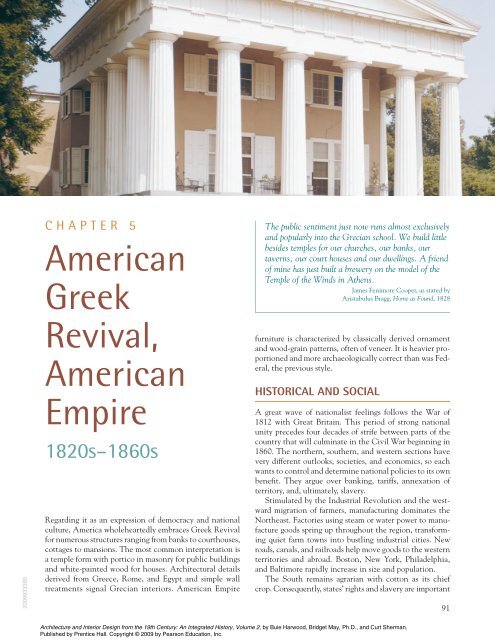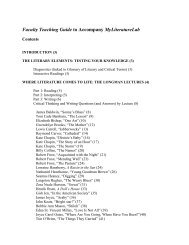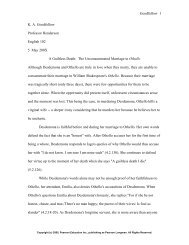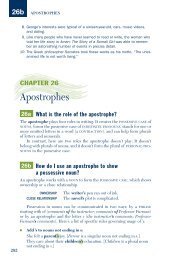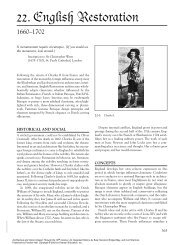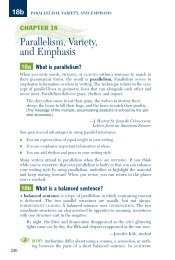American Greek Revival, American Empire - Pearson
American Greek Revival, American Empire - Pearson
American Greek Revival, American Empire - Pearson
You also want an ePaper? Increase the reach of your titles
YUMPU automatically turns print PDFs into web optimized ePapers that Google loves.
2009933390<br />
CHAPTER 5<br />
<strong>American</strong><br />
<strong>Greek</strong><br />
<strong>Revival</strong>,<br />
<strong>American</strong><br />
<strong>Empire</strong><br />
1820s–1860s<br />
Regarding it as an expression of democracy and national<br />
culture, America wholeheartedly embraces <strong>Greek</strong> <strong>Revival</strong><br />
for numerous structures ranging from banks to courthouses,<br />
cottages to mansions. The most common interpretation is<br />
a temple form with portico in masonry for public buildings<br />
and white-painted wood for houses. Architectural details<br />
derived from Greece, Rome, and Egypt and simple wall<br />
treatments signal Grecian interiors. <strong>American</strong> <strong>Empire</strong><br />
The public sentiment just now runs almost exclusively<br />
and popularly into the Grecian school. We build little<br />
besides temples for our churches, our banks, our<br />
taverns, our court houses and our dwellings. A friend<br />
of mine has just built a brewery on the model of the<br />
Temple of the Winds in Athens.<br />
James Fenimore Cooper, as stated by<br />
Aristabulus Bragg, Home as Found, 1828<br />
furniture is characterized by classically derived ornament<br />
and wood-grain patterns, often of veneer. It is heavier proportioned<br />
and more archaeologically correct than was Federal,<br />
the previous style.<br />
HISTORICAL AND SOCIAL<br />
A great wave of nationalist feelings follows the War of<br />
1812 with Great Britain. This period of strong national<br />
unity precedes four decades of strife between parts of the<br />
country that will culminate in the Civil War beginning in<br />
1860. The northern, southern, and western sections have<br />
very different outlooks, societies, and economics, so each<br />
wants to control and determine national policies to its own<br />
benefit. They argue over banking, tariffs, annexation of<br />
territory, and, ultimately, slavery.<br />
Stimulated by the Industrial Revolution and the westward<br />
migration of farmers, manufacturing dominates the<br />
Northeast. Factories using steam or water power to manufacture<br />
goods spring up throughout the region, transforming<br />
quiet farm towns into bustling industrial cities. New<br />
roads, canals, and railroads help move goods to the western<br />
territories and abroad. Boston, New York, Philadelphia,<br />
and Baltimore rapidly increase in size and population.<br />
The South remains agrarian with cotton as its chief<br />
crop. Consequently, states’ rights and slavery are important<br />
Architecture and Interior Design from the 19th Century: An Integrated History, Volume 2, by Buie Harwood, Bridget May, Ph.D., and Curt Sherman.<br />
Published by Prentice Hall. Copyright © 2009 by <strong>Pearson</strong> Education, Inc.<br />
91
92 LATE NEOCLASSICAL<br />
issues there. Because cotton is most often grown on large<br />
plantations using slave labor, the movement to abolish<br />
slavery that arises in the North angers Southerners. Slavery<br />
becomes a major issue in the annexation of western<br />
states and settlement of western territories such as Texas,<br />
Oregon, California, and New Mexico. Southerners also<br />
greatly resent the tariffs that protect northern manufactured<br />
goods.<br />
Migration westward accelerates, caused in part by manifest<br />
destiny, the notion that expansion is not only<br />
inevitable, but divinely ordained. However, most settlers<br />
simply desire to own their own land or to explore new territory.<br />
Although bringing benefits to the nation, expansion<br />
also increases disputes and controversy, particularly over<br />
slavery. Further complicating the western expansion, the<br />
United States clashes with Mexico over the annexation of<br />
Texas.<br />
Despite difficulties, the country prospers as a whole.<br />
Gold is discovered in California in 1848. Greater production<br />
of wheat, cotton, and manufactured goods increases<br />
wealth in the Midwest, South, and North, respectively.<br />
Affluent northern businessmen, manufacturers, and southern<br />
plantation owners live in large, well-furnished mansions.<br />
Slaves and settlers who live in one-room hovels, log cabins,<br />
and sod houses are at the opposite end of the scale. In<br />
between these groups is the sizable middle class, which has<br />
become sufficiently large and wealthy that merchants and<br />
manufacturers begin to provide goods and services for it.<br />
Schooling in the United States is local and traditional,<br />
which means that the extent (length and/or number of<br />
schools) depends on the resources of towns and cities and<br />
the ambitions of churches and other public and private<br />
groups. Members of the common-school movement advocate<br />
reform through systematic elementary education. The<br />
Industrial Revolution helps bring about a movement for<br />
women’s rights as working-class women begin to earn wages<br />
in factories, thereby gaining some independence. However,<br />
reforms are slow, and middle- and upper-class women see<br />
little change. They still are expected to be responsible for<br />
the home and child rearing and remain at home.<br />
CONCEPTS<br />
In America, the adoption of <strong>Greek</strong> <strong>Revival</strong> in architecture<br />
and <strong>American</strong> <strong>Empire</strong> in furniture coincides with a period<br />
of nationalistic fervor and enthusiasm for progress and personal<br />
liberty. Following the <strong>American</strong> Revolution, leaders,<br />
such as Thomas Jefferson, see classical antiquity as the<br />
source of ideal beauty and regard its citizens as models of<br />
civic virtue and morality. Thus, they choose classical-style<br />
architecture and furniture for themselves and for the<br />
architecture of the new nation and its model civilization.<br />
By the turn of the 19th century, <strong>Greek</strong> <strong>Revival</strong> assimilation<br />
of <strong>Greek</strong> modes is easy because many <strong>American</strong>s are<br />
� 5-1. Portrait of<br />
Dolly Madison.<br />
already familiar with Neoclassicism through the Federal<br />
style. Furthermore, classical studies form the basis for liberal<br />
arts education, and many see the <strong>Greek</strong> struggle for independence<br />
as a parallel to America’s ongoing fights with<br />
Great Britain. As a visual metaphor for beauty, democracy,<br />
republican government, liberty, and civic virtue, <strong>Greek</strong><br />
<strong>Revival</strong> defines numerous buildings, both rural and urban,<br />
high style and vernacular across the nation. It is America’s<br />
first national style.<br />
Sources of influence include archaeological books, such as<br />
The Antiquities of Athens (5 volumes, 1762–1816) by Stuart<br />
and Revett, and builders’ manuals, such as Asher Benjamin’s<br />
<strong>American</strong> Builder’s Companion in which the 6th edition of<br />
IMPORTANT TREATISES<br />
■ The <strong>American</strong> Builder’s Companion, 6th edition,<br />
1827; Asher Benjamin.<br />
■ The Architecture of Country Houses, 1850;<br />
Andrew Jackson Downing.<br />
■ The Builder’s Assistant, 3 volumes, 1818–1821;<br />
John Haviland.<br />
■ The Cabinet Maker’s Assistant, 1840; John Hall.<br />
■ An Encyclopedia of Cottage, Farm, and Villa<br />
Architecture and Furniture, 1830; John Claudius<br />
Loudon.<br />
■ The Modern Builder’s Guide, 1833; Minard<br />
Lafever.<br />
■ The Practical House Carpenter, 1830–1857;<br />
Asher Benjamin.<br />
■ The Young Builder’s General Instructor, 1829;<br />
Minard Lafever.<br />
■ Workwoman’s Guide, 1838; A Lady.<br />
Architecture and Interior Design from the 19th Century: An Integrated History, Volume 2, by Buie Harwood, Bridget May, Ph.D., and Curt Sherman.<br />
Published by Prentice Hall. Copyright © 2009 by <strong>Pearson</strong> Education, Inc.<br />
2009933390
2009933390<br />
1827 features <strong>Greek</strong> details. Few <strong>American</strong>s travel to Greece<br />
to see original models, although many professional architects<br />
either emigrate from Europe or are trained there. America<br />
has no schools of architecture at this time.<br />
Continuing the Neoclassical mode, <strong>American</strong> <strong>Empire</strong><br />
furniture develops from French <strong>Empire</strong> and English<br />
Regency influences. <strong>American</strong>s (Fig. 5-1) learn of European<br />
designs through widely circulated pattern books and<br />
pamphlets, when they travel abroad, or when they import<br />
furniture from England and France. New settlers often<br />
bring furniture with them, while cabinetmakers and<br />
� 5-2. Architectural details from Alabama, Mississippi, and Tennessee.<br />
� 5-3. Column details from Pennsylvania and Washington, D.C.<br />
AMERICAN GREEK REVIVAL, AMERICAN EMPIRE 93<br />
pattern books depict Europe’s latest fashions. French and<br />
English designers particularly important to the development<br />
of <strong>American</strong> <strong>Empire</strong> are Percier and Fontaine,<br />
Thomas Hope, and George Smith.<br />
DESIGN CHARACTERISTICS<br />
Although influenced by Europe, <strong>American</strong>s adapt English<br />
<strong>Greek</strong> <strong>Revival</strong> and French <strong>Empire</strong> to their needs, tastes,<br />
and situations. They create a unique classical expression<br />
Architecture and Interior Design from the 19th Century: An Integrated History, Volume 2, by Buie Harwood, Bridget May, Ph.D., and Curt Sherman.<br />
Published by Prentice Hall. Copyright © 2009 by <strong>Pearson</strong> Education, Inc.
94 LATE NEOCLASSICAL<br />
� 5-4. Door details from Indiana, Vermont, Tennessee, and Louisiana.<br />
that is often symmetrical and horizontal, but does not<br />
necessarily follow rules of classicism or reflect classical<br />
proportions. Liberties are taken frequently, either as a<br />
result of a lack of awareness, more concern for a classical<br />
look than correct use of classical forms and details, or simply<br />
as a way of adapting classicism to America.<br />
■ <strong>Greek</strong> <strong>Revival</strong>. Temple forms, the <strong>Greek</strong> orders, and simple<br />
white exteriors define <strong>American</strong> <strong>Greek</strong> <strong>Revival</strong> buildings.<br />
Structures, particularly domestic, often are wood, and<br />
there are far more vernacular buildings than there are in<br />
Europe. Grecian-style interiors in America are plainer and<br />
simpler than are those of Europe. Bolder architectural<br />
details and walls treated as one expanse mark the style.<br />
<strong>American</strong>s are less likely to imitate Etruscan or Pompeian<br />
modes than are the English and French, and they do not<br />
have an emperor to glorify like France.<br />
■ <strong>American</strong> <strong>Empire</strong>. <strong>American</strong> <strong>Empire</strong> furniture tends<br />
toward greater simplicity than does European, although<br />
forms and ornament derive from classical prototypes as in<br />
Europe. A late variation composed of broad flat areas,<br />
columns, and bold scrolls covered with plain or figured<br />
veneer is called Pillar and Scroll or Late Classical.<br />
Developing from inventions of the Industrial Revolution,<br />
the style follows furniture changes after the restoration of<br />
IMPORTANT BUILDINGS AND INTERIORS<br />
■ Austin, Texas:<br />
—Governor’s Mansion, 1855; Abner Cook.<br />
■ Athens, Georgia:<br />
—A. P. Dearing House, 1850–1856.<br />
—Grant-Hill-White-Bradshaw House,<br />
c. 1850s.<br />
—Joseph E. Lumpkin House, 1842.<br />
■ Boston, Massachusetts:<br />
—Quincy Market, 1825; Alexander Parris.<br />
the Bourbon monarchy in France. Unlike English Regency<br />
interiors and furniture, exotic or medieval styles and influences<br />
are rare in America.<br />
■ Motifs. Architectural details and motifs come primarily<br />
from Greece, but also from Rome and Egypt. They include<br />
egg and dart, bead, and dentil moldings, triglyphs and<br />
metopes, honeysuckles, anthemions, acanthus leaves, and<br />
the fret or key (Fig. 5-2, 5-25, 5-38). Interiors, furniture,<br />
and decorative arts exhibit a greater range of motifs from<br />
more sources, including Egyptian, <strong>Greek</strong>, Roman, and<br />
Renaissance. These include sphinxes, battered or pylon<br />
forms, paw feet, Egyptian or classical figures, lyres, harps,<br />
swans, dolphins, eagles, caryatids, serpents, arabesques,<br />
and columns (Fig. 5-26, 5-28, 5-39, 5-44, 5-45, 5-49).<br />
ARCHITECTURE<br />
As in other countries, <strong>American</strong> <strong>Greek</strong> <strong>Revival</strong> architecture<br />
relies on forms and elements derived from a few classical<br />
models adapted to contemporary requirements and<br />
ornament taken chiefly from Greece, but also Rome. Inspired<br />
by English buildings and publications, America adapts the<br />
style to its national consciousness. Nationalist expressions<br />
■ Bucks County, Pennsylvania:<br />
—Andalusia, 1833; Thomas U. Walter and Nicholas<br />
Biddle.<br />
■ Camden, South Carolina:<br />
—Bethesda Presbyterian Church, 1820; Robert Mills.<br />
—Bishop Davis House, 1820.<br />
■ Charleston, South Carolina:<br />
—First Baptist Church, 1822; Robert Mills.<br />
—Old Market Hall, early 19th century.<br />
Architecture and Interior Design from the 19th Century: An Integrated History, Volume 2, by Buie Harwood, Bridget May, Ph.D., and Curt Sherman.<br />
Published by Prentice Hall. Copyright © 2009 by <strong>Pearson</strong> Education, Inc.<br />
2009933390
2009933390<br />
IMPORTANT BUILDINGS AND INTERIORS<br />
—S. Phillips Church, 1835–1838; Joseph Hyde;<br />
steeple added in 1848–1850; E. B. White.<br />
■ Columbia, South Carolina:<br />
—Mills Building, State Hospital, 1821–1827;<br />
Robert Mills.<br />
■ Columbus, Ohio:<br />
—Ohio State Capitol, 1838–1861; Thomas Cole.<br />
—Old Courthouse, 1850; Howard Daniels.<br />
■ Demopolis, Alabama:<br />
—Gaineswood, 1843–1861; General Nathan Bryan<br />
Whitfield.<br />
■ Harwington, Connecticut:<br />
—Congregational Church, 1806.<br />
■ Madison, Indiana:<br />
—Costigan House, 1846–1849; Francis Costigan.<br />
■ Marshall, Michigan:<br />
—Harold Craig Brooks House, c.1840; architect<br />
possibly Richard Upjohn.<br />
■ Memphis, Tennessee:<br />
—Hunt-Phelan House, 1828–1840; Robert Mills.<br />
■ Nashville, Tennessee, area:<br />
—Belle Meade, 1854; Adolphus Heimann (?).<br />
—Hermitage, 1819, rebuilt 1836; David Morrison,<br />
later possibly Robert Mills.<br />
—Tennessee State Capitol, 1845–1859; William<br />
Strickland.<br />
■ Natchez, Mississippi:<br />
—D’Evereux, 1836–1840; James Hardie.<br />
—Dunleith, 1856.<br />
—Stanton Hall, 1857; Thomas Rose and Lewis<br />
Reynolds.<br />
■ New Haven, Connecticut:<br />
—First Church of Christ, Congregational, 1814;<br />
Ithiel Town.<br />
■ New Iberia, Louisiana:<br />
—Shadows-on-the-Teche, 1834.<br />
■ New Orleans, Louisiana:<br />
—Louisiana State Bank, 1820; Benjamin Henry<br />
Latrobe.<br />
—Old City Hall (Gallier Hall), 1845–1850; James<br />
Gallier, Sr.<br />
■ New York City, New York:<br />
—Customs House (now known as the Federal Hall<br />
National Memorial), 1833–1844; Ithiel Town<br />
and Alexander Jackson Davis with James Frazee.<br />
AMERICAN GREEK REVIVAL, AMERICAN EMPIRE 95<br />
■ Philadelphia, Pennsylvania:<br />
—Andalusia, 1798, remodeled 1836; Thomas U.<br />
Walter and Nicholas Biddle.<br />
—Girard College, Founders Hall, 1833–1847;<br />
Thomas U. Walter and Nicholas Biddle.<br />
—Fairmount Waterworks, 1812–1822; Frederick<br />
C. Graff.<br />
—Merchant’s Exchange, 1832–1834; William<br />
Strickland.<br />
—Second Bank of the United States (later known<br />
as the Customs House), 1817–1824; William<br />
Strickland.<br />
■ Pinewood, South Carolina:<br />
—Milford, 1838–1841; Charles Reichardt and<br />
Russell Warren (?).<br />
■ Quincy, Massachusetts:<br />
—Unitarian Church, 1828; Alexander Parris.<br />
■ Raleigh, North Carolina:<br />
—North Carolina State Capitol, 1833–1840;<br />
William Nichols, Jr., Ithiel Town and Alexander<br />
Jackson Davis, David Paton.<br />
■ Richmond, Virginia:<br />
—Linden Row, 1847, 1853; Otis Manson<br />
(builder).<br />
—Monumental Church, 1812; Robert Mills.<br />
—S. Paul’s Episcopal Church, 1843–1845; Thomas<br />
S. Stewart.<br />
—White House of the Confederacy (John<br />
Brockenbrough House), 1818; Robert Mills.<br />
■ Savannah, Georgia:<br />
—Trinity Church, 1848; John B. Hogg.<br />
■ Vacherie, Louisiana:<br />
—Oak Alley, 1832; attributed to Joseph Pilié.<br />
■ Washington, D.C., and nearby area:<br />
—National Patent Office (National Portrait Gallery),<br />
1836–1840; Robert Mills, William D. Elliot, and<br />
Ithiel Town.<br />
—The White House, Oval Portico and South<br />
Elevation, 1824; James Hoban.<br />
—Treasury Building, 1836–1842; Robert Mills.<br />
—Washington City Hall (U.S. District Court<br />
Building), 1817–1825; George Hadfield.<br />
■ Williamsburg, Massachusetts:<br />
—Josiah Hayden House, 1839.<br />
■ Winnsboro, South Carolina:<br />
—Fairfield County Courthouse, 1823; Robert Mills.<br />
Architecture and Interior Design from the 19th Century: An Integrated History, Volume 2, by Buie Harwood, Bridget May, Ph.D., and Curt Sherman.<br />
Published by Prentice Hall. Copyright © 2009 by <strong>Pearson</strong> Education, Inc.
96 LATE NEOCLASSICAL<br />
� 5-5. First Church of Christ, Congregational, 1814; New<br />
Haven, Connecticut; Ithiel Town.<br />
� 5-6. Fairmount Waterworks, 1812–1822; Philadelphia,<br />
Pennsylvania.<br />
and cultural symbolism unique to America aid in the adoption<br />
of <strong>Greek</strong> <strong>Revival</strong>. Various building types adapt temple<br />
forms, often in wood. This design variety sets the <strong>American</strong><br />
<strong>Greek</strong> <strong>Revival</strong> apart from its European counterparts.<br />
In egalitarian America, everyone can be a patron. Consequently,<br />
the <strong>Greek</strong> <strong>Revival</strong> temple form becomes the<br />
most common architectural icon for high-style government,<br />
commercial, and institutional buildings designed by<br />
architects and builders. It serves as a symbol of order,<br />
repose, and stability. Many <strong>American</strong>s live in temple-form<br />
houses, believing them to be the only proper dwelling for<br />
citizens of revived classical governments. High-style, vernacular,<br />
or folk interpretations of white temple-form<br />
houses dot the landscape, creating an image of <strong>Greek</strong><br />
simplicity. In towns named for <strong>Greek</strong> cities, such as<br />
Athens, Syracuse, or Troy, temple fronts often line quiet,<br />
tree-shaded streets. Because the style’s inception coincides<br />
with the population explosion and territorial expansion,<br />
� 5-7. First Baptist Church, 1822;<br />
Charleston, South Carolina; Robert Mills.<br />
Architecture and Interior Design from the 19th Century: An Integrated History, Volume 2, by Buie Harwood, Bridget May, Ph.D., and Curt Sherman.<br />
Published by Prentice Hall. Copyright © 2009 by <strong>Pearson</strong> Education, Inc.<br />
2009933390
2009933390<br />
DESIGN SPOTLIGHT<br />
Architecture: Second Bank of the United States (later<br />
known as the Customs House), 1817–1824; Philadelphia,<br />
Pennsylvania; William Strickland. The Second Bank of the<br />
United States is the first major example of <strong>Greek</strong> <strong>Revival</strong><br />
architecture in the United States. William Strickland’s<br />
design, which derives from the Parthenon for the first time<br />
in America, wins the competition held by the bank’s directors.<br />
Because he has not been to Greece, Strickland uses<br />
the restored views of the Parthenon from Stuart and<br />
Revett’s book as the model for the Doric porticoes on each<br />
end of the rectangular structure. In order to accommodate<br />
the windows, the design does not repeat the columns on<br />
the sides of the building. Marble veneer faces the entire<br />
structure. The gable roof conceals the barrel-vaulted banking<br />
room in the center of the plan. The building is very influential<br />
because the bank is one of the most important<br />
financial institutions in the country until the 1830s.<br />
� 5-9. Floor plan, first floor, Second Bank of the United States; Philadelphia, Pennsylvania.<br />
vernacular examples are far more numerous in America<br />
than they are in Europe.<br />
Public Buildings<br />
■ Types. Numerous <strong>Greek</strong> <strong>Revival</strong> banks, retail establishments,<br />
government and public works buildings, offices,<br />
institutions, colleges, bridges, monuments, and memorials<br />
AMERICAN GREEK REVIVAL, AMERICAN EMPIRE 97<br />
� 5-8. Second Bank of the United States, Philadelphia.<br />
proclaim the uniqueness of the new nation (Fig. 5-6, 5-8,<br />
5-13, 5-14). Some states such as Tennessee (Fig. 5-14),<br />
Connecticut, Kentucky, Indiana, North Carolina, and<br />
Ohio build <strong>Greek</strong> <strong>Revival</strong> capitol buildings. Pagan associations<br />
render the style inappropriate for churches, so only<br />
a few are built, mostly for reformed denominations.<br />
■ Site Orientation. Designers strive to isolate public<br />
buildings in the manner of the <strong>Greek</strong> acropolis instead of<br />
Architecture and Interior Design from the 19th Century: An Integrated History, Volume 2, by Buie Harwood, Bridget May, Ph.D., and Curt Sherman.<br />
Published by Prentice Hall. Copyright © 2009 by <strong>Pearson</strong> Education, Inc.
98 LATE NEOCLASSICAL<br />
� 5-10. Quincy Market, 1825; Boston, Massachusetts;<br />
Alexander Parris.<br />
� 5-11. Merchant’s Exchange, 1832–1834; Philadelphia,<br />
Pennsylvania; William Strickland.<br />
the Roman manner of relating buildings to each other.<br />
Although buildings in complexes relate to each other visually,<br />
they assert their individual character, as shown in<br />
the Fairmount Waterworks in Philadelphia (Fig. 5-6).<br />
Structures in cities often front important streets or parks.<br />
■ Floor Plans. Plans are generally rectangular and suitable<br />
to building function (Fig. 5-9). Most are symmetrical and<br />
oriented around important circulation spaces. Rooms vary<br />
in shape from square to round. Designers use great ingenuity<br />
in creating functional plans within the temple form but<br />
generally do not try to adapt ancient plans to contemporary<br />
needs.<br />
■ Materials. Building materials are usually local stone,<br />
granite, marble, and brick. Examples in wood may appear<br />
in more rural areas, particularly in southern states. Some<br />
are painted white, while others are left the color of the<br />
material. Public buildings often combine trabeated and<br />
� 5-12. Old Market Hall, 1841; Charleston, South Carolina.<br />
�5-13. Treasury Building, 1836–1842; Washington, D.C.;<br />
Robert Mills.<br />
arcuated construction by using columns along with vaults<br />
and domes.<br />
■ Façades. Temple fronts depicting the classical image and<br />
the <strong>Greek</strong> orders define <strong>Greek</strong> <strong>Revival</strong> façades (Fig. 5-6,<br />
5-7, 5-8, 5-10, 5-12, 5-14). Most buildings have porticos on<br />
one if not both ends, thereby emulating the Roman temple<br />
form. Few are peripteral. Some may give that impression<br />
with pilasters that continue the column rhythm, divide<br />
walls into bays, and simulate the post and lintel building<br />
system. Walls are flat with few projections other than porticoes.<br />
Basements sometimes are rusticated. Scale may be<br />
larger than that of the originals. Like their prototypes,<br />
structures are horizontal, symmetrical, and reflect clarity,<br />
repose, and stability.<br />
Some buildings closely imitate specific prototypes, such<br />
as Strickland’s Second Bank of the United States (Fig. 5-8),<br />
which emulates the Parthenon (447–436 B.C.E.; Athens,<br />
Architecture and Interior Design from the 19th Century: An Integrated History, Volume 2, by Buie Harwood, Bridget May, Ph.D., and Curt Sherman.<br />
Published by Prentice Hall. Copyright © 2009 by <strong>Pearson</strong> Education, Inc.<br />
2009933390
2009933390<br />
� 5-14. Tennessee State Capitol, 1845–1859; Nashville,<br />
Tennessee; William Strickland.<br />
� 5-15. Andalusia, 1833; Bucks County, Pennsylvania; Thomas<br />
U. Walter and Nicholas Biddle.<br />
Greece). Others do not copy earlier structures, so they vary<br />
greatly from the original <strong>Greek</strong> ones or display strong<br />
Roman influences. Designers may deviate from classical<br />
canons for creativity, individuality, or to distinguish <strong>American</strong><br />
buildings. A few structures, particularly those designed<br />
by architects, have cylindrical ends or projections,<br />
such as Merchant’s Exchange (Fig. 5-11), in the manner of<br />
<strong>Greek</strong> tholos or Hellenistic monuments. Some public structures,<br />
notably courthouses and state capitols, have domes<br />
and/or cupolas. Because there are no Grecian prototypes<br />
for domes or cupolas, designers look to the Choragic Monument<br />
of Lysicrates (c. 334 B.C.E.; Athens, Greece) or the<br />
octagonal Tower of the Winds (c. 40 C.E.; Athens, Greece)<br />
AMERICAN GREEK REVIVAL, AMERICAN EMPIRE 99<br />
DESIGN PRACTITIONERS<br />
■ Charles-Honoré Lannuier (1779–1819), a<br />
cabinetmaker, trains in Paris and immigrates to<br />
New York City in 1803. His early work is<br />
Directoire, but he soon adopts the <strong>Empire</strong> mode,<br />
becoming a leading exponent of the style. Lighter<br />
in scale than French, his furniture is often<br />
elaborately decorated and features caryatids.<br />
■ Robert Mills (1781–1855) studies with Benjamin<br />
Henry Latrobe and is one of the first professionally<br />
trained architects in America. He provides<br />
practical, if somewhat unimaginative, designs for<br />
many different building types, such as the first<br />
fireproof <strong>American</strong> building in Charleston, South<br />
Carolina. A leading exponent of <strong>Greek</strong> <strong>Revival</strong>, he<br />
is appointed official architect of government<br />
buildings. He designs the Treasury Building and<br />
Washington Monument in Washington, D.C.<br />
■ Duncan Phyfe (1768–1854) emigrates from<br />
Scotland and opens a shop in New York City in<br />
1792, soon becoming the city’s leading<br />
cabinetmaker. He is one of the principal creators<br />
of the <strong>American</strong> <strong>Empire</strong> style. The Grecian cross<br />
form is his innovation, and Phyfe characteristics<br />
include lyres for chair backs or table pedestals.<br />
■ Anthony Quervelle (1789–1856) develops a local<br />
version of <strong>American</strong> <strong>Empire</strong> in Philadelphia. His<br />
elegant furniture often displays exquisitely carved<br />
architectural motifs and foliage.<br />
■ William Strickland (1788–1854), like Robert<br />
Mills, studies with Benjamin Henry Latrobe and<br />
sets up an architectural practice in Philadelphia.<br />
A creative designer, he is known for his <strong>Greek</strong><br />
<strong>Revival</strong> designs, many of which he derives from<br />
Antiquities of Athens by Stuart and Revett. He<br />
also designs in Egyptian <strong>Revival</strong> and other styles.<br />
His Second Bank of the United States is the first<br />
fully <strong>Greek</strong> <strong>Revival</strong> structure in the country.<br />
■ Town and Davis is one of the earliest architectural<br />
partnerships in America. Founded in 1829 in New<br />
York City by Ithiel Town and Alexander Jackson<br />
Davis, the firm executes commissions in <strong>Greek</strong><br />
<strong>Revival</strong> and other styles. Lasting until 1835, the<br />
firm of Town and Davis produces influential<br />
designs for many different building types.<br />
for inspiration. The cupola of the Tennessee State Capitol<br />
in Nashville (Fig. 5-14) is modeled after the Choragic<br />
Monument of Lysicrates. Ornament on all building types is<br />
minimal and Grecian, most commonly a Doric frieze, the<br />
Architecture and Interior Design from the 19th Century: An Integrated History, Volume 2, by Buie Harwood, Bridget May, Ph.D., and Curt Sherman.<br />
Published by Prentice Hall. Copyright © 2009 by <strong>Pearson</strong> Education, Inc.
100 LATE NEOCLASSICAL<br />
DESIGN SPOTLIGHT<br />
Architecture: Rose Hill, 1835; Geneva, New York. Built<br />
in 1835 for the Swan family, Rose Hill illustrates<br />
common <strong>Greek</strong> <strong>Revival</strong> characteristics for residences.<br />
A graceful Ionic portico with pediment creates a temple<br />
image. Symmetrical, floor-length sash windows on the<br />
first floor allow access to the porch. The center doorway<br />
features small Ionic columns carrying an entablature<br />
with trabeated lights and sidelights over the single door.<br />
� 5-16. Rose Hill; Geneva, New York.<br />
anthemion, or <strong>Greek</strong> key. Architectural details are larger<br />
and bolder than Federal ones are.<br />
Churches continue the traditional form of porch with a<br />
tall steeple behind it, but with Grecian columns and other<br />
details (Fig. 5-5, 5-7). Steeples, which combine rectangular<br />
and cylindrical shapes, are modern creations because vertical<br />
Grecian prototypes are rare.<br />
■ Windows. Windows are rectangular and double hung.<br />
Arched, round, or Palladian examples are extremely<br />
rare because arches do not characterize <strong>Greek</strong> architecture.<br />
Decorative surrounds include pilasters, lintels, or<br />
pediments.<br />
■ Doors. Entrances are important and may be grandly<br />
treated with pilasters or columns (Fig. 5-3). Tops may be<br />
flat or may have pediments. Surrounds may be further embellished<br />
with classical moldings, such as egg and dart,<br />
triglyphs, <strong>Greek</strong> key, acanthus leaves, or palmettes.<br />
■ Roofs. Roofs are usually low-pitched gables resembling<br />
ancient temples (Fig. 5-6, 5-12). Some structures have flat<br />
roofs with balustrades. Domes with cupolas and cupolas<br />
alone often denote important spaces (Fig. 5-14).<br />
Flanking wings also have Ionic porches. The entire building<br />
is painted white. Inside, bold classical details around<br />
doors and windows and chimneypieces connect interior<br />
and exterior. Together with prominent cornices, plain<br />
ceilings, unarticulated painted or wallpapered walls,<br />
and <strong>Empire</strong> or Rococo <strong>Revival</strong> furniture, they provide<br />
formal settings for the rituals of entertaining guests<br />
and family.<br />
Temple front<br />
Pediment with plain tympanium<br />
Plain facade in white<br />
Ionic columns<br />
Floor-length sash windows<br />
Centered entry door flanked<br />
by Ionic columns<br />
Center axis emphasizes<br />
symmetry<br />
■ Later Interpretations. During the Neoclassical <strong>Revival</strong> of<br />
the late 19th and early 20th centuries, structures in the<br />
<strong>Greek</strong> <strong>Revival</strong> style are built. They are larger in scale than<br />
their predecessors were and more likely to be of brick or<br />
stone. <strong>Greek</strong> <strong>Revival</strong> is common for state and county courthouses<br />
in the first quarter of the 20th century. In the late<br />
20th century, interpretations of <strong>Greek</strong> <strong>Revival</strong> continue,<br />
but they may illustrate significant variations in image or<br />
materials.<br />
Private Buildings<br />
■ Types. Common house types include the temple form<br />
with or without wings, the gable end, and peripteral forms<br />
that are common on Southern plantations and mansions<br />
(Fig. 5-18, 5-22). Numerous classical porches, pilasters,<br />
and columns are added to existing houses for an updated<br />
Grecian appearance. Row houses and shotgun houses also<br />
feature <strong>Greek</strong> details (Fig. 5-21).<br />
■ Site Orientation. Houses may be sited in rural landscapes,<br />
along tree-lined streets in cities or towns, or as urban row<br />
Architecture and Interior Design from the 19th Century: An Integrated History, Volume 2, by Buie Harwood, Bridget May, Ph.D., and Curt Sherman.<br />
Published by Prentice Hall. Copyright © 2009 by <strong>Pearson</strong> Education, Inc.<br />
2009933390
2009933390<br />
� 5-17. Dr. John H. Matthews House, 1839; Painesville, Ohio;<br />
Jonathan Goldsmith.<br />
houses (Fig. 5-15, 5-16, 5-17, 5-21). A typical image for<br />
many today, but uncommon during the period, is a long<br />
double row of trees leading to the large columned plantation<br />
house.<br />
■ Floor Plans. Rectangular spaces again define floor plans<br />
(Fig. 5-19). Residences have few circular or apsidal rooms.<br />
The symmetrical, double-pile or Georgian plan of central<br />
hall with flanking rectangular rooms, common in the 18th<br />
century, remains typical for larger houses. To accommodate<br />
entrances on one side, plans of gable-end houses are often<br />
asymmetrical. Floor plans for temple forms with wings are<br />
the most functional and show the greatest variation. Most<br />
large homes have double parlors separated by sliding pocket<br />
doors.<br />
AMERICAN GREEK REVIVAL, AMERICAN EMPIRE 101<br />
■ Materials. Unlike public buildings, most houses are of<br />
wood that is painted white (Fig. 5-20). Some examples,<br />
particularly in the Northeast, are of brick, stone, or granite.<br />
Brick is sometimes painted white or covered with<br />
stucco and scored to resemble stone. Cast iron may be used<br />
for details or handrails of steps.<br />
■ Façades. Houses, to a greater extent than public buildings,<br />
re-create the ancient image by adopting temple forms<br />
and details. Temple fronts are definitive with columns on<br />
fronts only, front and sides, or surrounding the house<br />
(Fig. 5-15, 5-16, 5-18, 5-22). Doric is the most common<br />
column, followed by Ionic and Corinthian. Peripteral and<br />
other types may have no pediments (Fig. 5-20). Rectangular<br />
porches and porticoes may be full or partial width and<br />
have single or double stories. Fenestration may be symmetrical<br />
or asymmetrical. Walls, rarely divided into bays, are<br />
smooth. Gable-end or other vernacular house types may<br />
have corner pilasters to simulate a portico.<br />
Proportions often are very different from those of ancient<br />
structures. Because the classical idea is more<br />
important than archaeological correctness is, many liberties<br />
are taken whether resulting from ignorance, creativity,<br />
or individuality. Quadrangular pillars, unclassical treatments<br />
such as Doric columns with bases or plain shafts, or<br />
cupolas appear in both high-style and vernacular houses.<br />
Wide bands of trim, some with narrow horizontal windows,<br />
are common at the roofline. Trim may be in three parts, reflecting<br />
the classical entablature. Ornament is rare and<br />
found at doors and windows, beneath the cornice, and on<br />
columns and pilasters. Row houses sometimes have castiron<br />
handrails with palmettes, acanthus leaves, and other<br />
classical details.<br />
� 5-18. D’Evereux, 1840; Natchez,<br />
Mississippi.<br />
Architecture and Interior Design from the 19th Century: An Integrated History, Volume 2, by Buie Harwood, Bridget May, Ph.D., and Curt Sherman.<br />
Published by Prentice Hall. Copyright © 2009 by <strong>Pearson</strong> Education, Inc.
102 LATE NEOCLASSICAL<br />
� 5-19. Floor plan, first floor, D’Evereux, 1840; Natchez,<br />
Mississippi.<br />
■ Windows. Rectangular windows may have double or<br />
triple sashes (Fig. 5-15, 5-16, 5-17, 5-18). Those with<br />
triple sashes allow access to verandas. Exterior shutters<br />
are typical. The window surround may be plain and rectangular<br />
or have a pediment or ears. Elaborate ones have<br />
pilasters or decorative cresting. Tall windows may have<br />
decorative panels beneath. Windows on masonry examples<br />
may have lintels over them. Some houses have<br />
small rectangular frieze windows often with metal grilles<br />
near the roofline. Some houses have tripartite windows<br />
in the Palladian manner, but without the arched central<br />
window.<br />
■ Doors. Like windows, doors reflect the trabeated construction<br />
system in shape and ornament (Fig. 5-4).<br />
Columns or pilasters carrying a small entablature may<br />
flank entrances. A more typical treatment is a rectangu-<br />
� 5-20. Hardaway-Evans-Wilson-Sledge House, 1840; Mobile,<br />
Alabama.<br />
� 5-21. Linden Row, 1847, 1853; Richmond, Virginia.<br />
lar light above the door with flanking sidelights. Glass<br />
may be plain or have etched designs. The surround may<br />
have an entablature, pediment, or ears with and without<br />
decorative cresting. Classical moldings, the <strong>Greek</strong> key,<br />
� 5-22. Governor’s Mansion, 1855; Austin, Texas; Abner<br />
Cook.<br />
Architecture and Interior Design from the 19th Century: An Integrated History, Volume 2, by Buie Harwood, Bridget May, Ph.D., and Curt Sherman.<br />
Published by Prentice Hall. Copyright © 2009 by <strong>Pearson</strong> Education, Inc.<br />
2009933390
2009933390<br />
acanthus leaves, honeysuckles, or triglyphs may embellish<br />
the surround. Many affluent houses have a balcony<br />
above the entrance. Doors themselves are wood paneled<br />
and may be single or double.<br />
■ Roofs. Roofs may be flat without balustrades or lowpitched<br />
gables to resemble the temple (Fig. 5-15, 5-16,<br />
5-18). Some gables are steeper than the prototypes to allow<br />
for rain or snow. A few are hipped. Some have rectangular<br />
or cylindrical cupolas.<br />
■ Later Interpretations. As in public buildings, Neoclassical<br />
<strong>Revival</strong> houses sometimes replicate <strong>Greek</strong> <strong>Revival</strong> forms<br />
AMERICAN GREEK REVIVAL, AMERICAN EMPIRE 103<br />
� 5-23. Later Interpretation: “The<br />
Magnolia,” c. 1918; model house available<br />
through Sears, Roebuck and Company<br />
catalog. Neoclassical <strong>Revival</strong>.<br />
and details, but with larger scale and different materials<br />
(Fig. 5-23).<br />
INTERIORS<br />
<strong>Greek</strong> <strong>Revival</strong> interiors do not replicate those of the past<br />
because few examples survive. Public interiors have large<br />
and bold classical details rather than purely classical<br />
forms and treatments. Important rooms are grandly<br />
treated with columns, pilasters, moldings, and coffered<br />
ceilings. Spaces are generally rectangular, and those with<br />
Architecture and Interior Design from the 19th Century: An Integrated History, Volume 2, by Buie Harwood, Bridget May, Ph.D., and Curt Sherman.<br />
Published by Prentice Hall. Copyright © 2009 by <strong>Pearson</strong> Education, Inc.
104 LATE NEOCLASSICAL<br />
domes may be round or octagonal. A few spaces feature<br />
apsidal ends with a screen of columns separating the curving<br />
portions from the rest of the space. Domestic rooms<br />
are mostly rectangular spaces, but usually with an overall<br />
� 5-25. Rotunda, Customs House, New York City, 1834–1841; Town and Davis.<br />
� 5-24. Nave, First Baptist Church, 1822;<br />
Charleston, South Carolina; Robert Mills.<br />
simpler character than is evident in public interiors.<br />
Furnishings may or may not be classical because the<br />
Rococo and Gothic <strong>Revival</strong>s gain popularity toward the<br />
middle of the century.<br />
Architecture and Interior Design from the 19th Century: An Integrated History, Volume 2, by Buie Harwood, Bridget May, Ph.D., and Curt Sherman.<br />
Published by Prentice Hall. Copyright © 2009 by <strong>Pearson</strong> Education, Inc.<br />
2009933390
2009933390<br />
� 5-26. Doors from South Carolina, Pennsylvania, and Texas, c. 1830s–1850s.<br />
� 5-27. Windows from Massachusetts and Michigan, c.<br />
1840s–1850s.<br />
Public Buildings<br />
■ Relationships. Symmetry and regularity are important<br />
design principles. Interiors often have bold architectural<br />
details and display more embellishment and color than<br />
exteriors while maintaining a dignified and somber<br />
feeling.<br />
■ Color. Most color comes from materials such as the<br />
whites and grays of marble or stone. Somber colors for<br />
walls, such as stone, gray, or drab (gray-brown), are common.<br />
Many walls are marbleized. Doors and trim often are<br />
grained. Important rooms may have gilding on details.<br />
Drapery, upholstery, and carpets provide accents of<br />
stronger, saturated colors in deep reds, blues, greens, and<br />
golds (Fig. 5-25).<br />
AMERICAN GREEK REVIVAL, AMERICAN EMPIRE 105<br />
� 5-28. Parlor, William C. Williams House, 1810; Richmond,<br />
Virginia (Richmond Room, Metropolitan Museum of Art, New<br />
York); house possibly by Alexander Parris.<br />
■ Lighting. Interiors are lit with a combination of candlesticks,<br />
Argand lamps, astral lamps, lanterns, and hanging<br />
lamps (Fig. 5-39). Large windows admit natural light, and<br />
fireplaces also may provide illumination.<br />
■ Floors. Floors may be masonry, marble, or wood. Some<br />
important spaces have wall-to-wall carpets in bold geometric<br />
patterns with classical motifs and saturated colors of<br />
deep reds, blues, greens, or golds.<br />
Architecture and Interior Design from the 19th Century: An Integrated History, Volume 2, by Buie Harwood, Bridget May, Ph.D., and Curt Sherman.<br />
Published by Prentice Hall. Copyright © 2009 by <strong>Pearson</strong> Education, Inc.
106 LATE NEOCLASSICAL<br />
� 5-29. Section, White House of the Confederacy (John<br />
Brockenbrough House), 1818; Robert Mills.<br />
■ Walls. Bold architectural details articulate walls, particularly<br />
in important spaces (Fig. 5-24). Some walls are<br />
treated as one broad expanse with paint or wallpaper,<br />
whereas others are divided by a dado, fill, and cornice or<br />
are divided into bays with engaged columns or pilasters.<br />
■ Windows and Window Treatments. Plain or complicated<br />
moldings surround rectangular windows. Those in important<br />
rooms have lintels or pediments surmounting them.<br />
Window treatments (Fig. 5-27, 5-31, 5-35), when present,<br />
are composed of swags and festoons suspended from a<br />
gilded classical cornice, under-curtains of damask or velvet<br />
tied back, and a thinner material such as muslin next to the<br />
glass. Simpler treatments consist of panels hanging from<br />
rings on wooden rods.<br />
■ Doors. Doorways into important spaces have grand<br />
treatments with columns or pilasters or larger moldings<br />
with entablatures above. Doors may be single or double in<br />
paneled wood painted to match moldings, grained to imitate<br />
other woods, or sealed with a clear finish.<br />
■ Ceilings. Whereas some ceilings are plain with a plaster<br />
rosette, others may have coffers or may be compartmentalized<br />
combinations of circles, ellipses, and rectangles. Paint<br />
or gilding may highlight details.<br />
■ Later Interpretations. Classical-style interiors characterize<br />
Neoclassical <strong>Revival</strong> buildings, but they do not necessarily<br />
replicate <strong>Greek</strong> <strong>Revival</strong> characteristics.<br />
Private Buildings<br />
■ Types. Halls or passages (Fig. 5-32, 5-34) remain summer<br />
living spaces early in the period, but eventually<br />
become service areas or spaces for regulating social relationships.<br />
Many homes have double parlors, separated by<br />
sliding or pocket doors when needed or accented by<br />
�5-30. Dining room and graining details, Andalusia, 1833;<br />
Bucks County, Pennsylvania; Thomas U. Walter and Nicholas Biddle.<br />
Architecture and Interior Design from the 19th Century: An Integrated History, Volume 2, by Buie Harwood, Bridget May, Ph.D., and Curt Sherman.<br />
Published by Prentice Hall. Copyright © 2009 by <strong>Pearson</strong> Education, Inc.<br />
2009933390
2009933390<br />
DESIGN SPOTLIGHT<br />
Interiors: Parlor, Shadows-on-the-Teche, 1834; New<br />
Iberia, Louisiana. Constructed between 1831 and 1834,<br />
Shadows-on-the-Teche is owned by sugarcane planter<br />
David Weeks. The two-story gable-roofed house has a<br />
symmetrical façade of brick with double-hung windows.<br />
Colossal Tuscan columns carrying a Roman Doric frieze<br />
create the gallery or porch that runs across both stories,<br />
and an exterior stair on one side provides vertical circulation.<br />
Originally, the house was painted white with<br />
green shutters.<br />
This interior museum installation reproduces the parlor of<br />
an upper-middle-class house where guests are received<br />
� 5-31 Parlor, Shadows-on-the-Teche; New Iberia, Louisiana.<br />
columns (Fig. 5-26). The front parlor, used for entertaining,<br />
displays a feminine, elegant manner to impress visitors<br />
(Fig. 5-28, 5-31, 5-32). The rear or family parlor is<br />
less elegantly decorated and serves as a repository for older<br />
furnishings. Dining rooms are more common than they<br />
were before (Fig. 5-30, 5-33). Considered masculine<br />
spaces, they are somber in tone or rich and warm. Service<br />
areas are at the rear, in the basement, or completely separated<br />
from the house. The best chambers, located on the<br />
ground or second floor, often have elaborate, four-poster<br />
beds and large wardrobes (Fig. 5-37) to display wealth and<br />
prosperity.<br />
AMERICAN GREEK REVIVAL, AMERICAN EMPIRE 107<br />
and various rites and ceremonies take place. Fresco paper,<br />
in which borders form a paneled or compartmentalized<br />
design, in buff damask adorns the walls. On the floor is a<br />
multicolored wool Brussels carpet in a geometric-floral<br />
pattern. The window treatments are green damask with<br />
shaped valance and are tied back under curtains. A center<br />
table with an astral lamp and <strong>American</strong> <strong>Empire</strong>–style gondola<br />
chairs provide a place for people to gather. Additional<br />
furniture includes <strong>American</strong> <strong>Empire</strong> pier tables, side chairs,<br />
armchairs, and a sofa. The bold cornice, door surrounds,<br />
and rectangular marble with ormolu mantel clock and<br />
girandoles are common details in <strong>Greek</strong> <strong>Revival</strong> houses.<br />
Heavy cornice<br />
Fresco paper<br />
Astral lamp<br />
Black marble mantel<br />
Center pedestal table<br />
High baseboard<br />
Gondola or Seignouret chair<br />
Brussels carpet with<br />
geometric-floral pattern<br />
■ Relationships. Classical details unite interior with exterior.<br />
Symmetry and regularity are important design<br />
principles, as in public buildings. Interiors display more<br />
embellishment and color than do exteriors.<br />
■ Color. The Romantic interest in nature appears in colors<br />
with names like moss green, fawn brown, or stone gray.<br />
Early in the period, light values and neutral tones predominate.<br />
By midcentury, colors such as lilac, peach,<br />
bronze green, sage, and salmon are fashionable. Writers of<br />
pattern books specify colors based upon color theories.<br />
They recommend cool colors for south rooms and warm<br />
for north; sober tones, such as gray, buff, or drab for halls;<br />
Architecture and Interior Design from the 19th Century: An Integrated History, Volume 2, by Buie Harwood, Bridget May, Ph.D., and Curt Sherman.<br />
Published by Prentice Hall. Copyright © 2009 by <strong>Pearson</strong> Education, Inc.
108 LATE NEOCLASSICAL<br />
and light, elegant colors for parlors. Dining rooms may be<br />
red or green. Emphasizing the importance of placement,<br />
writers call for light ceilings, darker walls, and woodwork<br />
that is lighter or darker than the walls. They consider<br />
cornices especially important and recommend emphasizing<br />
them by contrasting colors to walls and ceilings.<br />
Graining and marbling are common on doors, woodwork,<br />
and fireplaces. Critics believe that bedrooms should be<br />
cheerful with light-colored walls and simple patterns.<br />
■ Lighting. Most people use a combination of firelight with<br />
candles and lamps for illumination, often choosing candles,<br />
which are less expensive and more portable than lamps. As<br />
in previous periods, levels of artificial illumination are low,<br />
but for entertaining, additional lighting signals hospitality.<br />
Candlesticks, candelabra, wall sconces, and lamps may be<br />
of glass, silver, bronze, and brass (Fig. 5-31, 5-39). Lead glass<br />
prisms embellishing the fixtures enhance light. Affluent<br />
and high-style parlors and dining rooms may have elegant<br />
cut-glass chandeliers suspended from carved ceiling medallions<br />
(Fig. 5-31, 5-32, 5-35). Argand lamps, tubular wick<br />
lamps with a reservoir to hold fuel, are more common than<br />
they were before (Fig. 5-39). They have single or double<br />
arms and are made in pairs or sets of three for use on a mantel.<br />
People substitute sinumbra or annular lamps for reading<br />
or on center tables.<br />
■ Floors. Wood floors predominate throughout the period,<br />
although more affluent homes sometimes have marble or<br />
other masonry flooring. Floors may be sealed with varnish,<br />
painted, or covered with floor cloths or carpets. Painted<br />
floors have solid colors or patterns, such as stripes or imitations<br />
of marble. Floor cloths in solid colors and patterns<br />
also remain popular, but not inexpensive.<br />
■ Floor Coverings. The use of carpets (Fig. 5-30, 5-31,<br />
5-32, 5-33) increases dramatically as a result of industrialization.<br />
Carpets usually are installed in narrow strips that<br />
are pieced together. Wall-to-wall carpets include Brussels,<br />
Wilton, ingrain, tapestry, and list. Brussels and Wilton remain<br />
expensive, but more <strong>American</strong>s than ever before can<br />
afford ingrain, list, tapestry, and Venetian carpets. Early in<br />
the period, carpets have geometric designs and classical motifs<br />
in several colors of which combinations of red and green<br />
are especially fashionable. Later patterns include trellises<br />
and stripes with flowers, imitations of Oriental rugs, and realistically<br />
shaded flowers. Hearth rugs in complementary<br />
patterns protect the carpet in front of fireplaces. Many still<br />
use crumb cloths to shield carpet beneath dining tables. In<br />
summer, carpet is taken up and replaced with grass matting.<br />
Matting is usually laid wall to wall with edges abutting. Easily<br />
cleaned and inexpensive, it comes in plain and patterned<br />
versions, but does not wear well.<br />
■ Walls. Walls are usually treated in one large expanse<br />
with paint or paper (Fig. 5-28, 5-29, 5-30, 5-31, 5-32, 5-34,<br />
5-36). Bold, decorative moldings, often with foliage or<br />
leaves, may compose cornices (Fig. 5-38). Baseboards are<br />
deeper than before. Rectangular, stone mantels, usually<br />
� 5-32. Entrance hall and parlors, Hermitage, 1819, rebuilt<br />
1836; Nashville, Tennessee; David Morrison, later possibly Robert<br />
Mills.<br />
black or white, resemble exterior door surrounds (Fig. 5-30,<br />
5-31, 5-35). Columns, brackets, or caryatids may support<br />
the shelf.<br />
■ Wallpaper. As in Europe, wallpaper use increases in<br />
<strong>American</strong> homes. Continuous rolls are common after<br />
1830; machine-made paper becomes available about 1820<br />
Architecture and Interior Design from the 19th Century: An Integrated History, Volume 2, by Buie Harwood, Bridget May, Ph.D., and Curt Sherman.<br />
Published by Prentice Hall. Copyright © 2009 by <strong>Pearson</strong> Education, Inc.<br />
2009933390
2009933390<br />
� 5-34. Stair hall, Charles L. Shrewsbury House, c.1849;<br />
Madison, Indiana.<br />
but does not dominate the market until the 1840s. Most<br />
papers continue to be hand-block printed, although roller<br />
print examples increase. New colors for papers include<br />
chrome yellow, French blue, and bright green.<br />
AMERICAN GREEK REVIVAL, AMERICAN EMPIRE 109<br />
� 5-33. Dining room, Melrose, c. 1840s;<br />
Natchez, Mississippi; John Byers.<br />
� 5-35. Music room, Rosedown Plantation, c. 1834–1859;<br />
St. Francisville, Louisiana.<br />
Wallpaper in many patterns comes from England, France,<br />
China, and America (Fig. 5-28, 5-32). French papers dominate<br />
the <strong>American</strong> market because <strong>American</strong>s favor their<br />
designs and colors. Landscape or scenic papers from France,<br />
particularly, are fashionable. Designed to cover the wall from<br />
dado to ceiling, landscape views have 20 to 30 panels per<br />
pattern. Panels are about 20' wide and 8' to 10' tall. The<br />
upper portion is sky with or without clouds and can be cut to<br />
fit the height of any room. The images depicted consist of<br />
numerous flat, opaque colors built up by printing individually<br />
with wooden blocks.<br />
Other patterns include architectural, ashlar, fresco, landscape,<br />
and textile or drapery imitations. Architectural papers<br />
imitate architectural details such as columns, coffered<br />
Architecture and Interior Design from the 19th Century: An Integrated History, Volume 2, by Buie Harwood, Bridget May, Ph.D., and Curt Sherman.<br />
Published by Prentice Hall. Copyright © 2009 by <strong>Pearson</strong> Education, Inc.
110 LATE NEOCLASSICAL<br />
ceilings, cornice moldings, or dadoes. Ashlar papers, simulating<br />
masonry or stone in appropriate colors, are recommended<br />
for passages and hallways. Fresco papers consist<br />
of vertical panels with flowers or foliage combined with<br />
� 5-36. Parlor and library, Gaineswood,<br />
1843–1861; Demopolis, Alabama; General<br />
Nathan Bryan Whitfield.<br />
� 5-37. Master bedroom, General Phineas Banning Residence,<br />
c. 1850s–1860s; Wilmington, California.<br />
columns and/or architectural moldings. Paper imitations<br />
of textiles or drapery substitute for the real thing in many<br />
homes. Also fashionable are rainbow (shaded) papers from<br />
France and small repeating flowers or geometric shapes.<br />
Borders complement all patterns.<br />
■ Windows. Plain or complicated moldings surround large<br />
rectangular windows. Some have lintels or pediments surmounting<br />
them (Fig. 5-27).<br />
■ Window Treatments. Many rooms continue to have interior<br />
shutters that fold into a shutter box in the window<br />
jamb when not in use. Shutters block light and provide<br />
Architecture and Interior Design from the 19th Century: An Integrated History, Volume 2, by Buie Harwood, Bridget May, Ph.D., and Curt Sherman.<br />
Published by Prentice Hall. Copyright © 2009 by <strong>Pearson</strong> Education, Inc.<br />
2009933390
2009933390<br />
� 5-38. Ceiling details from Virginia, Mississippi, and Louisiana, c. 1830s–1860.<br />
� 5-39. Lighting: Dolphin candlesticks, Argand lamps, urn<br />
chandelier, and glass chandelier, c. 1830s–1860s.<br />
AMERICAN GREEK REVIVAL, AMERICAN EMPIRE 111<br />
privacy. Parlors, dining rooms, and other important spaces<br />
usually have textile window treatments, which become<br />
more common during the period (Fig. 5-27, 5-31, 5-35).<br />
These treatments typically include swags and cascades or<br />
a shaped valance with trim and tassels, heavy trimmed<br />
side curtains tied back, sheer under-curtains, and a roller<br />
shade or blinds. As in Europe, swags and cascades, often<br />
with contrast linings and elaborate trims, are usual. <strong>American</strong>s<br />
also increasingly use the newly introduced French<br />
draw rod for curtains. Roller blinds made of white cotton<br />
or unbleached linen (called Holland cloth) debut in about<br />
1825. Windows in less important rooms have simple panels,<br />
sometimes with a valance. Rural houses often have no<br />
window treatments, as before.<br />
■ Doors. Doorways to important rooms have complex surrounds<br />
composed of architectural details such as pilasters<br />
carrying an entablature or battered moldings reminiscent<br />
of Egyptian gateways (Fig. 5-26). Other doorways have<br />
simpler surrounds. Doors are mahogany, walnut, or rosewood.<br />
Less expensive woods are grained to resemble the<br />
more expensive ones.<br />
■ Textiles. People increasingly use more fabrics than<br />
they did previously. However, textile wall treatments or<br />
tent rooms are less common in America than they are in<br />
Europe. Curtain fabrics and upholstery may be silk or<br />
chintz in the parlor, moreen in the dining room, and cottons<br />
for bedrooms. Fashionable rooms may have several<br />
Architecture and Interior Design from the 19th Century: An Integrated History, Volume 2, by Buie Harwood, Bridget May, Ph.D., and Curt Sherman.<br />
Published by Prentice Hall. Copyright © 2009 by <strong>Pearson</strong> Education, Inc.
112 LATE NEOCLASSICAL<br />
patterns of textiles instead of only one, as in earlier<br />
periods.<br />
■ Ceilings. Carved or cast plaster medallions or rosettes<br />
embellish the centers of some ceilings, while other ceilings<br />
are plain (Fig. 5-36, 5-38, 5-39, 5-43).<br />
FURNISHINGS AND DECORATIVE ARTS<br />
<strong>American</strong> <strong>Empire</strong> is heavier, plainer, and more sculptural<br />
than the earlier Federal. Carving, gilding, and classically<br />
inspired forms, such as the klismos and curule, define the<br />
image. The style antique, as it is called, borrows heavily<br />
from, but does not copy, French <strong>Empire</strong> and English Regency.<br />
Pillar and Scroll or Late Classical is a late version<br />
of <strong>American</strong> <strong>Empire</strong> that is characterized by simple forms,<br />
massive pillars, scrolls, and large expanses of mahogany<br />
veneer with no ormolu or gilding. Both <strong>American</strong> <strong>Empire</strong><br />
and Pillar and Scroll pieces are heavy and solid looking<br />
with good proportions. Case pieces tend to be rectangular,<br />
while chairs and sofas are more curvilinear. Regional<br />
variations evident in <strong>American</strong> <strong>Empire</strong> disappear in<br />
Pillar and Scroll, which is usually machine-made. Furniture<br />
maintains a relationship with archi-tecture because<br />
many cabinetmakers learn proportion, scale, and relationships<br />
using the classical orders as models.<br />
Technology and industrialization influence both styles.<br />
The new circular veneer saw slices veneers much thinner<br />
than before, enabling cabinetmakers to use rare exotic<br />
woods such as rosewood and apply veneers to curved surfaces<br />
without it splitting. The steam-drive lathe, introduced<br />
in the 1820s, contributes to the popularity of turned Roman<br />
legs. Cabinetmakers also adopt the French polish, a<br />
high-gloss and more quickly applied lacquer-based finish.<br />
At the end of the 1830s, the steam-driven band saw that<br />
can cut intricate curves in any thickness of wood comes<br />
into general use. The period also marks the beginning of<br />
mass-produced furniture. People continue purchasing<br />
custom furniture from small cabinetmaking shops but<br />
� 5-40. Side chairs, c. 1810s–1850s; Maryland and Louisiana.<br />
� 5-41 Cabinet and upholstery articles, c. 1833; New York City,<br />
New York; manufactured by Joseph Meeks and Sons.<br />
� 5-42. Hitchcock chair, 1826–1843; Hitchcocksville,<br />
Connecticut; Lambert Hitchcock.<br />
Architecture and Interior Design from the 19th Century: An Integrated History, Volume 2, by Buie Harwood, Bridget May, Ph.D., and Curt Sherman.<br />
Published by Prentice Hall. Copyright © 2009 by <strong>Pearson</strong> Education, Inc.<br />
2009933390
2009933390<br />
� 5-42. Continued.<br />
� 5-43. Parlor, Old Merchant’s House, 1830s; New York<br />
(Furniture Museum, East Village, New York City).<br />
now can buy other furniture from auction houses, merchants,<br />
upholsterers, and large retail establishments.<br />
Public and Private Buildings<br />
■ Types. Furniture types from earlier periods continue.<br />
Innovative forms include the klismos and curule for seating,<br />
the Grecian couch, and sleigh or French bed (Fig.<br />
5-35, 5-40, 5-48). Also, new to the period are the center<br />
table and the pianoforte, both of which commonly grace<br />
parlors (Fig. 5-31, 5-32, 5-41, 5-43).<br />
AMERICAN GREEK REVIVAL, AMERICAN EMPIRE 113<br />
� 5-44. Plain sofas, c. 1820s–1840s.<br />
■ Distinctive Features. Dark wood, carving, and brass<br />
mounts distinguish <strong>American</strong> <strong>Empire</strong>, while veneers, minimal<br />
embellishment, and scrolls define Pillar and Scroll or<br />
Late Classical (Fig. 5-44, 5-45, 5-46). Both styles, with the<br />
exception of pillar and scroll chairs, tend toward rectilinear<br />
forms and sharp corners. Case pieces rest on solid bases<br />
or paw feet. Classical motifs are common.<br />
■ Relationships. Furniture maintains its perimeter location,<br />
but chairs increasingly move to the center when not in use.<br />
Sofas may be at right angles to the fireplace, and center<br />
tables are common.<br />
■ Materials. Mahogany is the most popular wood followed<br />
by cherry, maple, and exotic woods, such as rosewood.<br />
Many pieces are veneered; others are painted or grained to<br />
imitate marble, ebony, or rosewood. Brass mounts and<br />
other details are common on <strong>Empire</strong> examples, but rare on<br />
Late Classical or Pillar and Scroll, which is very plain and<br />
relies on line for interest. Between 1807 and 1815, brass<br />
mounts from Europe are unobtainable because of import<br />
restrictions, so stenciled decorations and inlay are substituted.<br />
Painted furniture remains fashionable. Pieces may<br />
be painted completely or have color or ebonizing accentuating<br />
feet, drawers, or column supports. Typical colors<br />
include yellow ochre, red, green, blue, and black. Pressed<br />
glass knobs appear on furniture soon after patents for them<br />
are awarded in 1825 and 1826.<br />
Architecture and Interior Design from the 19th Century: An Integrated History, Volume 2, by Buie Harwood, Bridget May, Ph.D., and Curt Sherman.<br />
Published by Prentice Hall. Copyright © 2009 by <strong>Pearson</strong> Education, Inc.
114 LATE NEOCLASSICAL<br />
DESIGN SPOTLIGHT<br />
Furniture: Sideboards, c. 1820s–1840s. The sideboard<br />
is the most impressive piece in the <strong>Greek</strong> <strong>Revival</strong> dining<br />
room. Intended to proclaim wealth and to display<br />
objects, silver and glass are carefully arranged on its<br />
top. Most have drawers and cupboards for storage of<br />
� 5-45. Sideboards, c.<br />
1820s–1840s.<br />
■ Seating. Seating furniture often is part of suites of furnishings<br />
that include chairs, sofas, window seats, card<br />
tables, and pier tables in matching designs (Fig. 5-30,<br />
5-31, 5-32, 5-41, 5-43). Most rooms have numerous<br />
chairs of which the <strong>Greek</strong> klismos is the most common<br />
antique form. Examples may closely or loosely follow<br />
items associated with dining. Broad expanses of mahogany,<br />
classical details, and large scale define the<br />
<strong>American</strong> <strong>Empire</strong> sideboard. These examples illustrate<br />
the variety in form and design.<br />
Curved drawer front<br />
Mahogany<br />
Curved arch on storage door<br />
Engaged Tuscan column<br />
Emphasis on straight lines<br />
and large scale<br />
Animal paw feet<br />
the klismos form (Fig. 5-28, 5-40). Leg types include<br />
turned, X-shaped, cornucopia, saber, and quadrangular.<br />
Chair backs may have horizontal, vase, eagle, or lyre<br />
splats. Animal feet, brass-paw toecaps, and casters are<br />
common. Reeding and carved or painted classical motifs<br />
may highlight backs and rails. Chairs with caned seats<br />
Architecture and Interior Design from the 19th Century: An Integrated History, Volume 2, by Buie Harwood, Bridget May, Ph.D., and Curt Sherman.<br />
Published by Prentice Hall. Copyright © 2009 by <strong>Pearson</strong> Education, Inc.<br />
2009933390
2009933390<br />
� 5-46. Chest of drawers, c. 1820s–1840s.<br />
usually have cushions with tassels for comfort. Gondola<br />
chairs (Fig.5-31, 5-40) derived from French <strong>Empire</strong><br />
forms are also fashionable. Grecian cross-legged chairs<br />
and sofas have X-shaped or curule legs that may face<br />
either the front or sides.<br />
AMERICAN GREEK REVIVAL, AMERICAN EMPIRE 115<br />
� 5-47. Wardrobes, c. 1820s–1850s; New York, Louisiana, and<br />
Texas.<br />
Fancy chairs are popular versions of klismos or Sheraton<br />
styles. They have rush seats, turned legs, and stenciled<br />
decorations and may be painted black, yellow, or<br />
green. To simulate gilding, bronze dust may be sprinkled<br />
onto still-wet varnish. Although many firms make them,<br />
those by Lambert Hitchcock in Connecticut are the best<br />
known (Fig. 5-42). They are especially popular in New<br />
England. Stools or tabourets become increasingly popular<br />
throughout the period and sometimes are used as<br />
window seats.<br />
Every elegant parlor has at least one sofa (Fig. 5-43,<br />
5-44). Plain sofas, as they are called, have identical<br />
Architecture and Interior Design from the 19th Century: An Integrated History, Volume 2, by Buie Harwood, Bridget May, Ph.D., and Curt Sherman.<br />
Published by Prentice Hall. Copyright © 2009 by <strong>Pearson</strong> Education, Inc.
116 LATE NEOCLASSICAL<br />
� 5-48. Sleigh beds and four-poster bed, c. 1820s–1850s; Louisiana and Washington, D.C.<br />
� 5-49. Textiles: Cotton and wool, and quilt, c. 1820s–1860s.<br />
scrolled ends, a long wooden crest, and lion’s paw or cornucopia<br />
feet. Expensive examples feature carving, reeding<br />
or fluting, and veneer. Box types are rectangular with<br />
heavy turned legs and feet. Grecian sofas (Fig. 5-35),<br />
derived from <strong>Greek</strong> prototypes, have complex scrolls,<br />
backs often not as long as the seat, and saber legs. They<br />
often appear in pairs. Ottoman sofas are benches without<br />
arms that are commonly used as window seats.<br />
Toward the end of the period, elaborate and carved<br />
forms in seating gradually give way to simple veneered<br />
and scrolled forms in the Pillar and Scroll style.<br />
Especially popular in America is the Pillar and Scroll<br />
rocker with curving arms and upholstered seat and back<br />
(Fig. 5-37). It is sometimes referred to as a Lincoln<br />
rocker because President Abraham Lincoln is depicted<br />
in one.<br />
■ Tables. Center tables with round wooden tops often<br />
have central pedestals that may be carved or fluted, resting<br />
on a circular, triangular, or a rectangular base with paw or<br />
rounded feet (Fig. 5-31, 5-32, 5-41). Some center tables<br />
have caryatid, dolphin, scrolled, or bracket supports. Card<br />
tables have pedestals that may be fluted or shaped into<br />
lyres, eagles, or caryatids. Dining tables continue to be<br />
made in pieces so that they can be taken apart when not in<br />
use (Fig. 5-30, 5-33). Pedestals (called pillar and claw) are<br />
heavier than before and may have richly carved or brass<br />
paw feet. Rectangular pier tables used for serving food or<br />
holding dishes, decorative objects, or lighting are placed<br />
symmetrically, usually between windows, in the parlor and<br />
dining room (Fig. 5-32). Heavy columns or scrolls support<br />
the marble tops. Mirrored backs double the apparent size<br />
and reflect light. Below the shelf are rounded or paw<br />
feet that may be ebonized or painted green with inlaid<br />
brass rings.<br />
■ Storage. The sideboard, which dominates the dining<br />
room, is one of the most impressive pieces in the house<br />
Architecture and Interior Design from the 19th Century: An Integrated History, Volume 2, by Buie Harwood, Bridget May, Ph.D., and Curt Sherman.<br />
Published by Prentice Hall. Copyright © 2009 by <strong>Pearson</strong> Education, Inc.<br />
2009933390
2009933390<br />
� 5-50. Later Interpretation: “Phrenology,” decorated chest of<br />
drawers, 1991; Rob Womack. Modern Historicism.<br />
(Fig. 5-33, 5-45). Used for display and storage, it has<br />
drawers and doors on the sides and a long drawer in the<br />
center with pediment above. Some sideboards have<br />
columns or pilasters on the corners and paw feet. Chests<br />
of drawers in bedchambers, or bureaus as <strong>American</strong>s call<br />
them, have three or four drawers with an overhanging<br />
top and columns on each side (Fig. 5-46). The piece may<br />
rest on paw feet. Desks and bookcases have flat tops,<br />
glass doors, and a rectangular base with a drop front that<br />
reveals the writing surface. Pleated yellow or green silk<br />
behind doors protect books from sunlight. The less popular<br />
secrétaire à abattant is rectangular with a pediment<br />
and drop front. Wardrobes are tall and massive with two<br />
doors (Fig. 5-47). Columns and/or paw feet may embellish<br />
them.<br />
■ Beds. Four-poster beds continue in use, but posts are<br />
heavier and carved with classical ornament and other<br />
motifs (Fig. 5-37, 5-48). A heavy canopy with curved<br />
moldings often rests on the posts. A tall, carved headboard<br />
and/or pediment adds to the grandeur. Bed hangings remain<br />
opulent with swags or other complicated designs<br />
forming valances. French or sleigh beds have head- and<br />
footboards of equal height (Fig. 5-48). They are of dark<br />
AMERICAN GREEK REVIVAL, AMERICAN EMPIRE 117<br />
wood with bright brass mounts. Over the bed, a rounded<br />
canopy may attach to the wall and support draped hangings<br />
of richly trimmed silk, cottons, or wool, sometimes<br />
with a contrast lining.<br />
■ Textiles. The most common upholstery fabrics are<br />
horsehair, plush, silk, wool, and leather. Some covers<br />
have a central medallion for the back and seat and<br />
running decorative details for edges. Sometimes, sofas<br />
and chairs are further embellished with heavy shawl<br />
fringe. Furniture covers protect fabrics both in the summer<br />
and winter. Quilt-making becomes popular for<br />
women, with designs pieced together or embroidered on<br />
a fabric surface (Fig. 5-49). Flowers and eagles are popular<br />
motifs. Quilts usually cover beds.<br />
■ Decorative Arts. More accessories and pictures appear<br />
in interiors during the period. Pictures and paintings<br />
hang symmetrically by slender cords from picture<br />
moldings mounted below the cornice. Mirrors reflect<br />
<strong>Empire</strong> design characteristics such as heavier proportions<br />
and rich carving. The round mirror in a heavy<br />
frame with a convex glass and an eagle motif remains<br />
very fashionable (Fig. 5-28, 5-35). English, <strong>American</strong>,<br />
and Chinese export porcelains, large in scale and<br />
classical in form, decorate mantels and pier tables<br />
and form large dinner sets. English transfer-printed<br />
ceramic wares are especially popular. Made specifically<br />
for the <strong>American</strong> market, pieces feature engraved<br />
images of <strong>American</strong> buildings or landscapes, portraits of<br />
<strong>American</strong> heroes, or other designs with an <strong>American</strong><br />
theme.<br />
During the 1830s, pressed glass dinnerware, candlesticks<br />
(Fig. 5-39), and lamps begin to be produced in a<br />
wide range of patterns, colors, and at reasonable prices. An<br />
<strong>American</strong> invention, pressed glass competes with more expensive<br />
domestic and imported cut glass and has a significant<br />
impact upon glass making in America and Europe.<br />
Forms and motifs may be classical. Most patterns feature<br />
densely packed flowers, foliage, volutes, and scrolls, a result<br />
of the manufacturing process. Silver is large in scale<br />
with classical forms, such as urns or columns, and classical<br />
decoration such as acanthus leaves. The wealthy have ormolu<br />
mantel clocks, and many <strong>American</strong>s can now afford<br />
wooden wall and mantel clocks.<br />
■ Later Interpretations. Reproductions and adaptations of<br />
<strong>American</strong> <strong>Empire</strong> and Pillar and Scroll furniture are introduced<br />
during the late 20th century as <strong>American</strong>s restore<br />
old houses with period-style furnishings (Fig. 5-50). The<br />
newer interpretations are often desired because of<br />
improved functional considerations, such as wider beds<br />
and more storage compartments or places for televisions or<br />
computers in wardrobes.<br />
Architecture and Interior Design from the 19th Century: An Integrated History, Volume 2, by Buie Harwood, Bridget May, Ph.D., and Curt Sherman.<br />
Published by Prentice Hall. Copyright © 2009 by <strong>Pearson</strong> Education, Inc.


